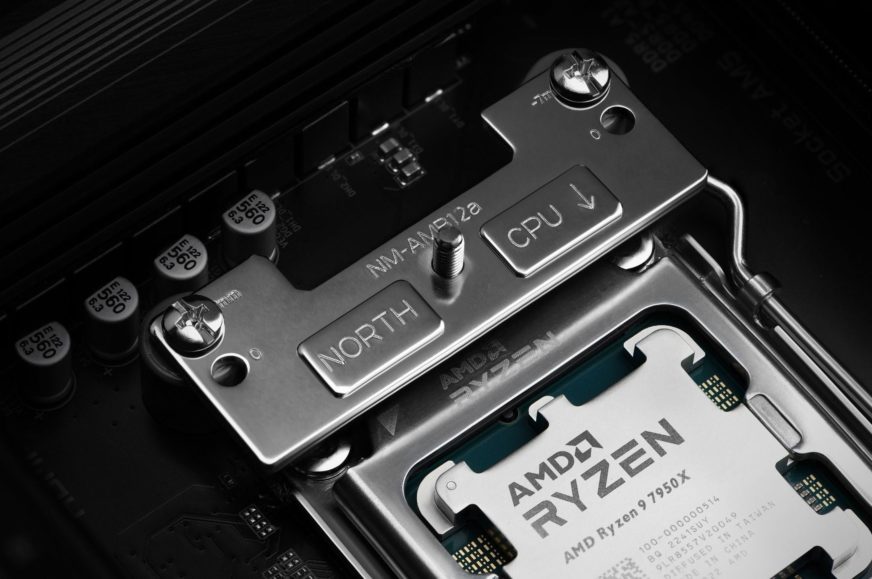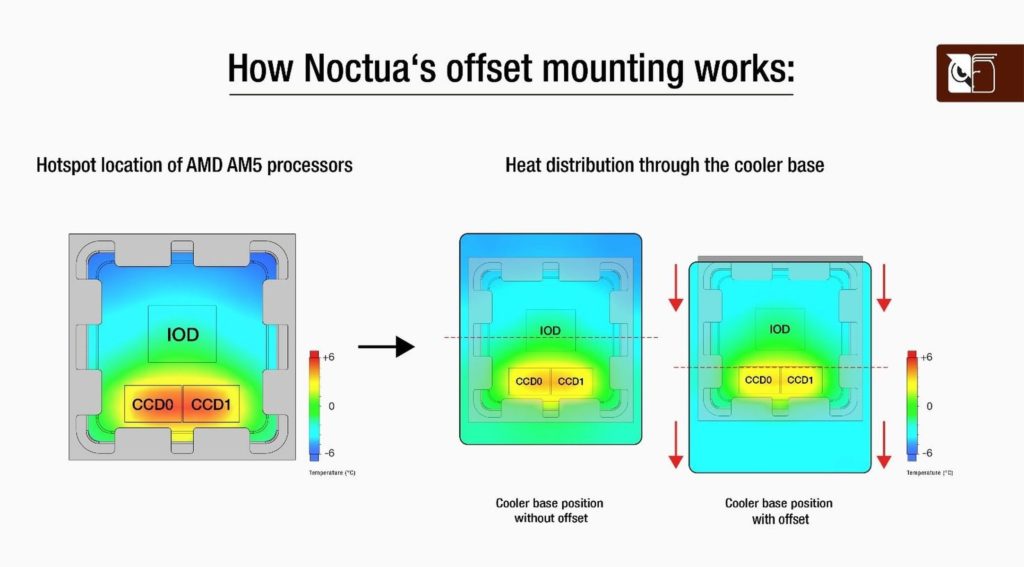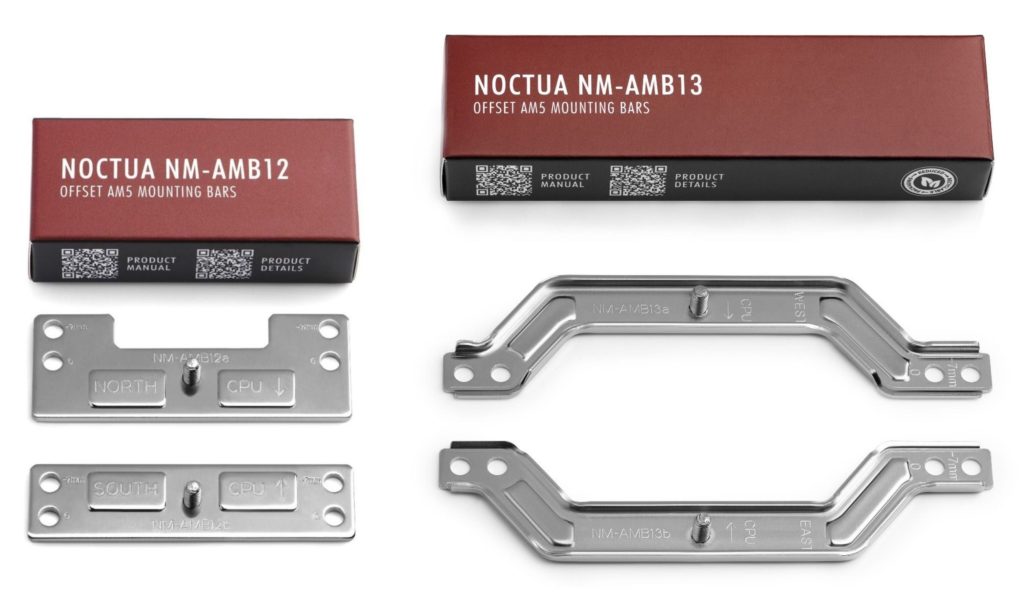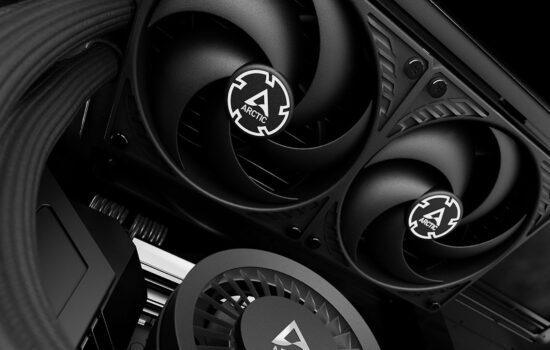Nopctua NM-AMB
The first time Noctua revealed the modified bars for more effective cooler contact with the chiplet-based Ryzens was just a few days ago, at Computex. The NM-AMB bars are now available in stores and Noctua is revealing more details about them. They are primarily designed for the AMD AM5 platform, but older AM4 processors are also supported. While the impact of the bars is noticeable at times, other times they’re not really worth it.
How do the mounting bars contribute to cooling?
CPU coolers usually count on the silicon chip of the CPU being in the middle of the PCB. It also tries to exert the highest pressure at these locations for the sake of the fastest heat transfer, typically by coldplate convexity, which tends to be centered. However, AMD’s chiplet processors are not helped much because their hotspots are in the bottom half of the PCB. In the middle is the I/O chip, which the coolers apply higher pressure to, but the key highest heat loss is on the CCD chipsets. And the new Noctua NM-AMB bars are designed to move the higher cooler pressure in that direction, further south, closer to the chiplets with CPU cores. Specifically, by 7mm, at which point the base of the cooler is still in contact with the entire surface of the CPU IHS.
After this modification, it is used more evenly and the result is a reduction in processor temperatures of “as much as” 3.1 °C . This is the specific case of the Ryzen 9 7950X at 190W with the NH-D15 cooler. With the Ryzen 7 7700X (115 W) with a top-flow cooler NH-L12S, however, using offset bars as measured by Noctua, the temperatures will drop only by 1.3 °C.
NM-AMB offset bars are also compatible with older AM4 processors, but the improvement is supposed to be at best 1 °C, so negligible. This is naturally due to the fact that even the most powerful Ryzen 5000s ended up at a PPT of 142 W, although for the R7 5800X it was in a relatively small area, within a single CCD chipset. But still, if Noctua calculates with all AM4 models when specifying the range of 0.5–1.0 °C, the drop in temperature will be symbolic for this processor as well. Noctua mentions testing on Ryzen 7 (5800X3D and 3800X) with a single active CCD chiplet, but also on two-chiplet Ryzen 9 (5950X and 3950X). With these processors, the measured difference was always below 1.0 °C.
As far as the AM5 platform is concerned, and it will be similar on AM4, at similar power draw with a similarly powerful cooler, the temperature drop is likely to be greater on processors that have only one chiplet active (i.e. from Ryzen 7700X downwards). For these, a greater amount of heat is concentrated on the same surface area. You can also see this behaviour in Noctua’s internal materials, where there is a similar gain for the R7 7700X compared to the R9 7950X (-2.8 °C – R7 7700X vs. -3.1 °C – R9 7950X), although the power draw of the R7 7700X (130 W) is about a third lower than that of the R9 7950X (190 W), and that’s with a slightly weaker cooler used on the R7 7700X (NH-U12A). With the NH-D15 cooler that the R9 7950X is presented with in the results, the temperature difference between those CPUs would be even smaller.
Faster heat dissipation is also important in terms of single-threaded workloads, where although the overall power draw is relatively low, the high cooling requirements of active cores (typically two that alternate on a task) remain. The clock speed of a single-core boost depends on the temperature. The Ryzen 9 7950X with the Noctua NH-U14S cooler exceeds 70°C even in above-standard conditions under single-threaded load, and falls short of the maximum theoretical clock speed of 5.85 GHz. And the power draw is below 60 W.
There are four types of NM-AMB bars in total, two of them (NM-AMB12 and NM-AMB13) are designed for coolers with larger mounting hole spacing and two bars (NM-AMB14 and NM-AMB15) are for coolers that have a smaller mounting hole spacing of 78 mm. Details around which cooler supports which bars can be found on Noctua’s product pages.
The bars are then also differentiated according to the required orientation, the shorter NM-AMB12 and NM-AMB14 allow for the rare horizontal mounting that most manufacturers on the AMD platform have long ignored.
However, mass demand will probably eventually be for the NM-AMB13 and NM-AMB15 models for traditional mounting. That is, one where the fan on the tower cooler is oriented in the same axis as the fan on the back of the computer case for system cooling.
All bars have a plain, “silver” finish and NM-AMB12 and NM-AMB15 also have a chromax.black variant. The NM-AMB12, NM-AMB14 and NM-AMB15 can be purchased immediately either directly via the order form at noctua.at (for 3.90 EUR) or alternatively through Amazon, where you’ll pay an extra euro for faster delivery. If you have an older cooler that needs the NM-AMB13 bars, you’ll have to wait a while, they should be ready to ship in one to two weeks.
English translation and edit by Jozef Dudáš
- Contents
- Nopctua NM-AMB














